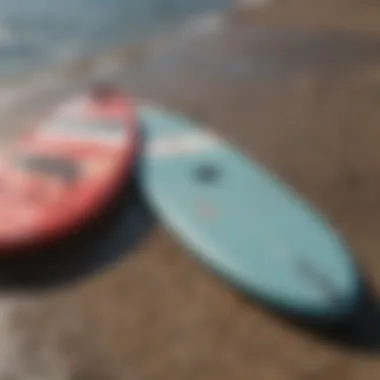Understanding Entry-Level Paddle Boards: A Comprehensive Guide


Intro
Paddle boarding, a sport that has gained significant popularity in recent years, offers a unique blend of tranquility and adventure. This activity allows participants to engage with nature, providing a sense of freedom on the water. As its name suggests, paddle boarding involves standing on a large board while using a paddle to navigate lakes, rivers, or oceans.
A Brief History
The roots of paddle boarding can be traced back to ancient civilizations, particularly the Polynesians who used large canoes for transportation and fishing. However, modern paddle boarding emerged in the 1960s in Hawaii when surfers began using larger boards to capture the waves and monitor surf conditions. Over the years, it evolved into the accessible and enjoyable sport we recognize today, accommodating enthusiasts of different skill levels.
Equipment Required
To start paddle boarding, a few essential items are needed:
- Paddle Board: Choosing the right board is crucial. Entry-level boards are generally wider and more stable, making them ideal for beginners.
- Paddle: A suitable paddle, typically made of lightweight material, enhances the paddling experience.
- Leash: A leash ensures you stay connected to your board, preventing it from drifting away.
- Personal Flotation Device (PFD): Safety should always be a priority, and wearing a PFD is recommended, especially in open water.
- Appropriate Clothing: Depending on conditions, wearing a wetsuit or swim attire might be necessary.
Safety Tips and Guidelines
Engaging in paddle boarding, like any water-based sport, comes with its own set of risks. It's essential to keep safety in mind. Here are some guidelines:
- Always wear a life jacket, especially if you are a novice.
- Check local weather and water conditions before heading out.
- Stay aware of your surroundings to avoid obstacles or other watercraft.
- Paddle with a buddy when possible to increase safety.
- Learn about local regulations regarding paddle boarding in specific areas.
Relevant Statistics and Facts
Paddle boarding is not just a fun activity; it has seen increasing participation rates. According to recent studies, over 3.1 million people in the US alone engage in paddle boarding. The activity appeals to a range of demographics, with a notable presence of both young adults and older participants. This statistic illustrates the versatility and broad appeal of paddle boarding.
Understanding these elements lays the groundwork for delving into more specific topics such as design features, material considerations, and performance metrics of entry-level paddle boards, all of which equip potential buyers to make informed choices.
Prologue to Paddle Boarding
Paddle boarding has surged in popularity as a versatile water sport, appealing to a diverse demographic. Understanding the fundamentals of this activity is essential, especially for those interested in entry-level paddle boards. This section emphasizes the importance of grasping basic concepts, terminology, and historical significance of paddle boarding, as it lays the groundwork for informed decisions about equipment and techniques.
Definition and Overview
Paddle boarding involves standing on a long board and propelling oneself across the water using a paddle. The practice can take place on various bodies of water, including lakes, rivers, and oceans. The boards differ in size, shape, and materials, impacting performance and suitability for different types of paddlers.
Entry-level paddle boards are specifically designed with ease of use in mind. They generally offer enhanced stability and durability, making them ideal for beginners. Moreover, they tend to be versatile enough for various conditions and casual paddling experiences. Some common purposes include recreational paddling, yoga, fishing, and touring. As such, having a solid understanding of the basic elements of paddle boarding is crucial, especially for newcomers looking to embark on this fun and engaging sport.
Historical Context of Paddle Boarding
Paddle boarding has deep roots stretching back to ancient civilizations. While similar practices can be traced to various cultures, modern paddle boarding as we know it mainly evolved from Hawaiian tradition. The original use of wooden boards by Hawaiian surfers can be seen as a precursor to today's paddle boards.
During the late 20th century, paddle boarding gained traction in the United States, particularly in California. Surfers began using paddles to navigate waves more efficiently, thus creating a bridge between surfing and paddle boarding.
In recent years, paddle boarding has transformed into a recreational activity that attracts individuals of all skill levels. It offers an accessible way to engage with nature, promote fitness, and socialize. Therefore, understanding the history and evolution of this sport adds valuable context to the current landscape of paddle boards, particularly for those searching for entry-level solutions.
Significance of Entry-Level Paddle Boards
Entry-level paddle boards possess a critical role in the landscape of paddle boarding. They serve as an accessible gateway for beginners and casual enthusiasts to engage with the sport. Understanding their significance requires a closer look at affordability, usability, and the foundational skills they help develop.
Why Choose Entry-Level Equipment
Entry-level paddle boards are designed to minimize barriers to entry. These boards provide a balance of cost and performance, making them attractive for those who may be hesitant to invest heavily in a sport they are just beginning to explore. The lower price point encourages experimentation without a significant financial risk.


These boards typically prioritize stability over speed. This aspect benefits newcomers who need reliable support while they learn to navigate and balance on the water. The user-friendly characteristics allow beginners to feel more confident, enhancing their overall experience. An entry-level board reduces the intimidation factor, which can be prevalent in more advanced paddle boards. As a result, paddlers can focus on developing technique rather than worrying about equipment limitations.
Bridging the Skills Gap
Entry-level paddle boards play an important role in bridging the skills gap between inexperienced novices and more advanced users. They facilitate a gradual improvement in skills, allowing paddlers to gain comfort and competence in water. By utilizing these boards, users can develop essential skills such as paddling technique, balance, and maneuvering without feeling overwhelmed by complex equipment demands.
As individuals grow more skilled, the experience gained from using entry-level boards can lead to informed decisions about upgrading to a specialized board when the need arises. The initial investment in an entry-level board can effectively serve as a stepping stone, guiding paddlers toward identifying their preferences in equipment as they progress.
"Choosing the right entry-level paddle board is crucial; it shapes your experience and learning curve in this rewarding sport."
Ultimately, entry-level paddle boards not only enhance the experience of newcomers but also encourage a longer-term interest in the sport, making them invaluable in cultivating a community of dedicated paddlers.
Key Features of Entry-Level Paddle Boards
Entry-level paddle boards serve as the gateway to the world of paddle boarding. Understanding their key features is essential for novices and seasoned paddlers alike. These features not only define how a board performs but also influence a user's experience on the water. Characteristics such as design, materials, and fin set-up play significant roles in determining the suitability of a paddle board for different skill levels.
Design Characteristics
Width and Stability
Width is a vital factor regarding stability in paddle boards. Wider boards provide greater stability, which is particularly essential for beginners. A broader surface area increases the contact with the water, making it less likely for users to tip over. For entry-level paddlers, a board width between 30 to 36 inches is often optimal. This characteristic is beneficial because it allows users to focus on paddling rather than balancing. However, the trade-off may be reduced speed and maneuverability, which some more advanced paddlers prefer.
Length and Speed
Length matters significantly when it comes to speed. Longer boards glide through the water efficiently and are preferred by paddlers seeking speed. Ideal lengths for entry-level boards generally range from 10 to 12 feet. This range accommodates beginners while allowing for some growth as skills improve. However, while length enhances speed, it can complicate handling for newer users. A shorter board might be easier to control but may drag in terms of speed.
Material Considerations
Hard vs Inflatable Boards
The material choice is between hard and inflatable boards. Hard boards offer better overall performance and responsiveness, making them suitable for flat water and surf conditions. They tend to be more stable at higher speeds. Inflatable boards, on the other hand, provide portability and ease of storage. This characteristic makes them a popular choice among casual paddlers. Nevertheless, they may lack some stability in rough water compared to hard boards, which is an important consideration depending on where one intends to paddle.
Durability Factors
Durability affects the longevity and performance of a paddle board. Entry-level boards should withstand the rigors of use while maintaining shape and performance. It is common for manufacturers to use materials like high-density polyethylene or aluminum for hard boards, contributing to their durability. Inflatable boards, often made from military-grade PVC, are also built to endure various conditions. The right material choice enhances the lifespan of the board, but purchasers must consider how often they will use it and the environments in which they will be paddling.
Fin Set-Up
Types of Fins
Fin type is critical to a board's overall performance. Entry-level paddle boards commonly use single or tri-fin setups. A single fin provides straightforward tracking but can limit maneuverability, while a tri-fin setup offers better control and stability in varying conditions. Beginners often benefit from the simplicity of a single fin, allowing them to focus on honing their skills without overwhelming complexity.
Impact on Performance
The fin configuration directly impacts performance, particularly concerning tracking and cornering ability. A well-designed fin set-up helps maintain a straight line during paddling. For novice paddlers, this is essential as it assists in developing paddling technique without constant corrections. Advanced users, however, may prefer boards that allow for fin customization to suit their specific paddling style or conditions. Understanding this balance is important when choosing an entry-level paddle board.
"Choosing the right paddle board involves understanding these key features that impact your performance on water."
In summary, understanding the key features of entry-level paddle boards helps potential buyers align their choices with their skill levels and paddling goals. Each decision, including design, material, and fin set-up, plays into the overall experience and effectiveness on the water.
Performance Metrics to Consider
Evaluating performance metrics is crucial when selecting an entry-level paddle board. These metrics can significantly influence the overall experience for the paddler. When beginners or enthusiasts assess these factors, they enhance safety, enjoyment, and skill development. Understanding how each metric affects performance helps in making informed choices that align with personal goals and conditions.


Speed and Agility
Speed and agility are often paramount for water sports enthusiasts. Speed determines how quickly a paddle board can traverse the water. Entry-level paddle boards tend to have a broader design, offering stability in exchange for speed. However, newer designs increase potential speed without sacrificing safety.
Agility concerns how easily a board can turn and respond to the paddler's movements. A board with good agility allows the user to navigate through obstacles more effectively, enhancing the overall paddling experience.
When comparing different models, look for specifications about maximum speed and suggested usage. Some brands offer performance metrics, allowing users to balance speed and comfort.
Weight Capacity
Weight capacity is another vital metric. Each paddle board has a maximum weight limit based on its dimensions and materials. Exceeding this limit can lead to decreased performance and increase the risk of an accident.
Beginners often weigh less than more experienced athletes. Thus, it's important to consider equipment that accommodates potential gear for excursions. Look for boards that allow for extra weight to account for factors like gear or even a friend joining you.
- Board Weight rating: Ensure the board supports your total weight and any extra load.
- Safety margins: Consider choosing a board that allows for your weight plus a margin for safety, typically 20-30% higher.
Tracking and Maneuverability
Tracking refers to how straight the paddle board moves through water. Good tracking helps a paddler maintain a direct line, making for a smoother ride. Conversely, poor tracking may require more effort to remain on course, potentially leading to fatigue.
Maneuverability indicates how easily a paddler can adjust to changing water conditions. A highly maneuverable board can navigate through choppy waters, around bends, or past obstacles with ease. Both tracking and maneuverability often rely on factors like board shape and fin setup.
Consider boards with a design that promotes both tracking and agility for a well-rounded experience. As an example, wider boards might help with stability while providing limited tracking, whereas narrower boards can enhance speed and tracking at the expense of stability.
"Choosing a board that balances speed, weight capacity, and maneuverability is essential for beginners to develop their skills effectively."
Understanding these performance metrics is essential. By keeping these factors in mind, entry-level paddlers can select boards that enhance their learning experience while ensuring safety and enjoyment.
Ideal Buyer Profile
Understanding the ideal buyer profile is crucial in the realm of entry-level paddle boards. This section is designed to assist potential buyers in determining their position in the paddling spectrum, ensuring they choose equipment that enhances their experience and skill development. Selecting the right board significantly influences not just enjoyment but also safety and progression in paddle boarding.
Through identifying key buyer types, manufacturers can tailor products more effectively. Likewise, customers gain clarity on their options and what to consider based on their current skill set. Entry-level paddle boards serve a diverse audience, where knowing oneself and the requirements can lead to more informed decisions.
Beginners: Key Considerations
When entering the sport of paddle boarding, beginners must take several considerations into account.
- Stability: A wider board generally offers more stability. This aspect is vital for novice paddlers still adjusting their balance on the water.
- Length: Longer boards tend to track better, but they can be harder to maneuver for someone still learning the basics.
- Weight: Ensure that the weight capacity of the board accommodates the paddler and any gear. Boards with a lower capacity might not perform well under heavier loads.
- Material: For beginners, inflatable boards can often be a good choice due to their portability and safety features. An inflatable board is less likely to cause injury during falls.
- Cost: Entry-level boards should fit within a reasonable price range that reflects the user’s commitment to the sport as well as their budget.
Prioritizing these factors will foster a smoother introduction to paddle boarding.
Intermediate Users: When to Upgrade
For those with some experience, knowing when to upgrade is an essential part of growth.
Signs that an intermediate user may consider upgrading include:
- Enhanced Skills: As confidence and technical abilities improve, a user might seek boards that offer better performance characteristics.
- Exploring Different Environments: Paddlers interested in varying water conditions may find they need specialized boards suited for surf, racing, or touring.
- Board Limitations: If the current board does not meet speed, tracking, or capacity needs, it might be time to evaluate options that provide these capabilities.
- Frequent Use: Users who paddle often might desire boards made from more durable materials, which maintain performance over time.
An upgraded board can result in an improved experience, allowing for greater exploration and mastery of the sport. Always consider the type of paddling you want to do before making changes.
Market Trends in Entry-Level Paddle Boards


Understanding market trends in entry-level paddle boards is crucial for anyone looking to make an informed purchase. The paddle board industry is dynamic, influenced by advancements in design, materials, and consumer preferences. Keeping an eye on these trends allows prospective buyers to recognize not only what features are gaining popularity but also how these changes may enhance their paddling experience.
This section will delve into popular brands and their innovations, as well as customer feedback and reviews. By doing so, we will highlight the factors that influence the choices of novices and seasoned paddlers alike. Informed decisions can lead to a better alignment between the paddle board's capabilities and the user's expectations.
Popular Brands and Innovations
Numerous brands dominate the entry-level paddle board market, each bringing unique innovations that cater to a variety of paddlers. Brands like iROCKER, Aqua Marina, and Bote are known for their commitment to quality and performance.
- iROCKER: Recognized for its inflatable paddle boards, iROCKER emphasizes stability and durability. Their recent models feature drop-stitch technology, which provides a rigid structure without adding too much weight.
- Aqua Marina: This brand is notable for offering affordable options with well-thought-out designs. Their latest innovations include lightweight construction combined with effective tracking systems.
- Bote: A brand known for premium features, Bote combines practicality with aesthetics. Their multi-functional boards allow for fishing or relaxing on the water, appealing to a varied audience.
Aside from brand-specific innovations, several trends are noteworthy:
- Eco-friendly Materials: A growing number of manufacturers are using sustainable materials. This shift not only appeals to environmentally conscious consumers but also enhances the performance of the boards.
- Customization Options: Some brands are now allowing customers to personalize their boards. This feature caters to individual preferences and enhances customer satisfaction.
Customer Feedback and Reviews
The significance of customer feedback cannot be overstated in the paddle board market. Reviews provide prospective buyers with insights into real-world performance, which can be more valuable than marketing claims. Various platforms, such as Reddit and Facebook, offer spaces for paddlers to share their experiences.
- Durability Concerns: Many users emphasize the importance of durability, especially concerning inflatable boards. Buyers often report their experiences with different brands, highlighting the stability and lifespan of the boards.
- User Experience: Beginners may comment on how easy or difficult it was to use a specific board. This feedback helps others gauge whether the board fits their skill level.
- After-sales Service: Positive or negative reviews regarding customer service can significantly influence purchasing decisions. Brands known for responsive support tend to attract more buyers.
"Real users often highlight practical pros and cons that help new paddlers make the right choices."
In summary, staying updated on the market trends of entry-level paddle boards gives buyers a competitive edge. Understanding what features and brands are leading the way, along with authentic user experiences, can significantly influence one’s purchasing decision.
Care and Maintenance
Maintaining entry-level paddle boards is essential for ensuring their longevity and performance. Proper care can significantly extend the life of a paddle board while also providing a safer experience on the water. Understanding how to care for these boards helps paddlers avoid common pitfalls that can affect performance and safety. Key elements include cleaning, storage, and overall maintenance practices.
Cleaning Considerations
Cleaning paddle boards after each use is crucial. Sand, saltwater, and other debris can cause potential damage over time. Here are some recommendations for proper cleaning:
- Freshwater Rinse: After every use, rinse the board with freshwater to remove salt, sand, or any contaminants that can erode materials.
- Mild Soap Use: If the board is particularly dirty, a small amount of mild soap can be used. Avoid abrasive cleaners as they can scratch the surface.
- Soft Cloth or Sponge: Use a soft cloth or sponge to clean the surface. Rough materials can leave scratches.
- Inspect Regularly: During cleaning, inspect for any signs of wear or damage. Look for cracks, peeling, or rough areas.
Cleaning is not just about aesthetics; it protects the board from degradation and maintains its performance.
Storage Recommendations
How paddle boards are stored significantly impacts their condition. Adopting proper storage techniques can prevent unnecessary wear. Consider the following storage tips:
- Dry Environment: Store your paddle board in a cool, dry place out of direct sunlight. UV rays can degrade the materials over time.
- Avoid Ground Contact: Using a rack or cushion system keeps the board off the ground and prevents deformation and material issues.
- Deflate Inflatable Boards: If using an inflatable board, ensure it is completely deflated before storage to minimize wear on seams.
- Protective Covers: Utilize a cover to shield the board from dust and environmental factors, especially if storing for extended periods.
We should not underestimate the importance of proper storage as it directly relates to the paddle board's lifespan. Investing time in care and maintenance proves beneficial in the long run.
Culmination
The significance of the conclusions drawn in this article on entry-level paddle boards cannot be overstated. Choosing the right paddle board is crucial for both novice and intermediate paddlers, directly impacting their experiences on the water. The various components discussed—design features, materials, performance metrics, and ideal buyer profiles—serve as critical elements that inform decision-making. Understanding these aspects not only enhances individual enjoyment but also contributes to improved skills over time.
Final Thoughts on Entry-Level Paddle Boards
Entry-level paddle boards cater to a wide range of users, from absolute beginners to those with some experience looking to advance. Key considerations for selecting the right board revolve around stability, durability, and ease of handling. As outlined, the stability of a board is paramount. Wider boards typically offer greater stability, making them suitable for new paddlers.
Inflatable paddle boards often present a great balance between portability and performance, making them a popular choice. Likewise, hard boards might be preferred for those focusing on speed and performance as they tend to be stiffer and more responsive.
"Selecting an entry-level paddle board should not be just about the price tag; it requires an exploration of personal needs and goals."
In addition to design and material considerations, performance metrics such as weight capacity and maneuverability play crucial roles in choosing the right equipment. Understanding how these features align with one’s paddling goals can lead to greater satisfaction and confidence when out on the water.
Overall, entry-level paddle boards offer a gateway into the sport, enabling individuals to cultivate their skills while enjoying the serene beauty of waterways. Ultimately, being aware of the factors discussed in this article arm users with the knowledge necessary to make informed choices that enhance their paddling experience.



